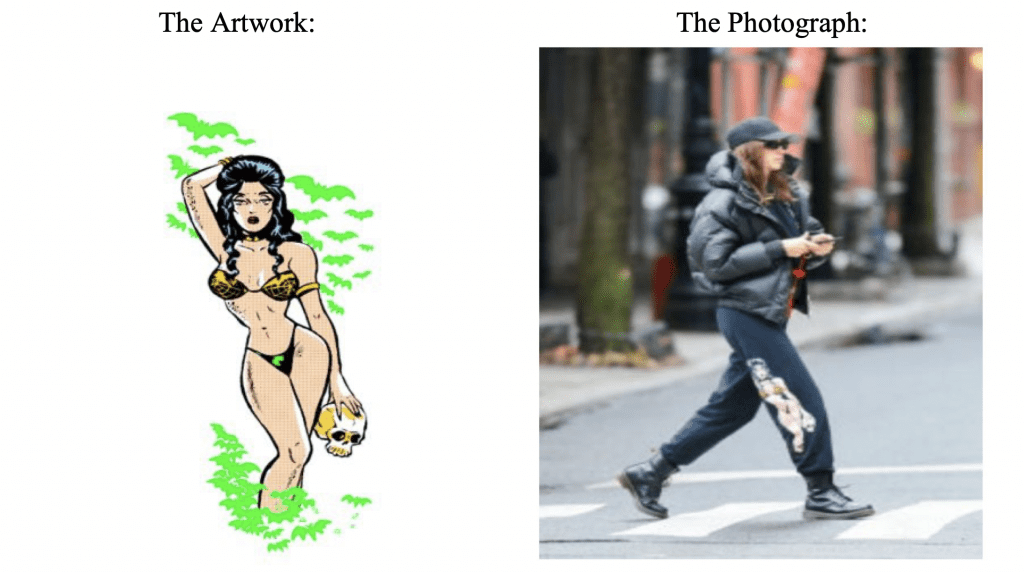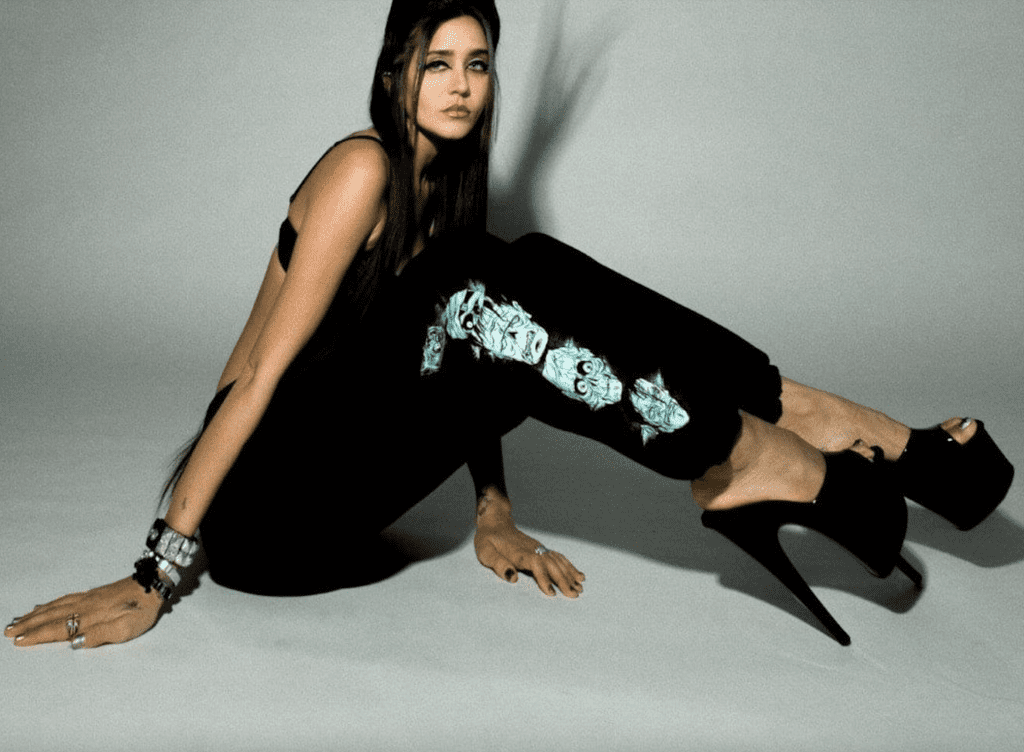An interesting lawsuit involving a paparazzi photo is currently unfolding before a federal court in California. The matter got its start just like many of the paparazzi photographer-initiated cases that have flooded dockets in New York and California in recent years, with a paparazzi filing a copyright infringement lawsuit against a fashion brand (or a celebrity) for posting one of his photos on Instagram without authorization or a license. In this case, Carlos Vila filed a lawsuit against Deadly Doll in July 2021 for posting one of his images – a photo of model Irina Shayk walking down the street in a pair of the brand’s sweatpants – on its Instagram. The infringing photo is “an exact copy of the entirety of [Vila’s] original image that was directly copied and [posted] by Deadly Doll on [its Instagram] account,” Vila asserted in the 8-page complaint that he filed with the U.S. District Court for the Central District of California.
Instead of quietly settling the lawsuit out of court, which has been the pattern for the majority of the long list of paparazzi-waged copyright lawsuits, Deadly Doll responded to Vila’s complaint in September 2021 with claims of its own. Primarily, Deadly Doll alleged that in taking the photo of Shayk and subsequently offering it up for license to media outlets, Vila captured “a ‘Pin-up’ girl image in which Deadly Doll owns the copyright that was on clothing Deadly Doll created without [its] permission.” In doing so, Deadly Doll claims that Vila created an unauthorized derivative work. (Who else is not buying this argument?)
In asserting its counterclaims, Deadly Doll also took issue with Vila’s “alleged ‘copyright’ in the unauthorized derivative photograph” of Shayk, and sought a declaration from the court that its copyright in the artwork is valid, while the “alleged copyright in [Vila’ photo] is invalid.” (Both Vila and Deadly Doll maintain copyright registrations for their respective works: the photo for Vila and the pin-up girl artwork for Deadly Doll.)
On the heels of filing his answer to Deadly Doll’s counterclaims, complete with a fair use affirmative defense, Vila lodged a motion for judgment on the pleadings this spring, angling to get Deadly Doll’s counterclaims tossed out on the basis that his photo containing Deadly Doll’s pin-up girl art is not a “derivative work” as a matter of law – and thus, does not infringe the brand’s copyright in the artwork. Beyond that, Vila argued that he is entitled to judgment on the pleadings because “Deadly Doll is not entitled to declaratory judgment, Deadly Doll’s copyright in the artwork is invalid, and [his] photograph constitutes fair use of the artwork.”

(Deadly Doll – which was founded by musician Jesse Jo Stark, whose parents Richard Stark and Laurie Lynn Stark are the duo behind cult label Chrome Hearts – pushed back in a subsequent opposition filing. The company argued that since Vila’s photograph incorporated “virtually all of” its pin-up girl art, which is “conceptually separable, copyrightable, and copyrighted,” the photo qualifies as a derivative work that infringes Deadly Doll’s copyright, making it “ineligible for independent copyright protection under the law of the Ninth Circuit and other courts.”)
Fast forward to August 23 and the Judge Otis Wright of the U.S. District Court for the Central District of California sided with Deadly Doll, finding that Vila is not entitled to judgment on the pleadings on all four fronts.
Derivative Work – First, the judge states that Vila argues that his photograph is “highly unlikely to be considered a derivative work under Ninth Circuit precedent, which protects photographers from their inherent vulnerabilities to copyright infringement suits based on the individual copyrighted elements necessarily captured in their photographs.” However, he “does not—and cannot—cite to any precedent stating that photographs can never be derivative works of any artwork displayed therein,” Judge Wrights states.
“Accordingly, the question of whether the photograph is a derivative work still requires the Court to determine whether the photograph recasts, transforms, or adapts the artwork” – a question of fact to be established on summary judgment or determined at trial.
Vila’s Copyright – Vila’s second argument – in which he claims that Deadly Doll cannot possibly prevail on its claim for declaratory relief because his photo meets the Ninth Circuit’s “extremely low” threshold for originality and thus, is sufficiently original to warrant its own copyright protection – similarly fails. “By citing precedent that merely suggests Deadly Doll is unlikely to prevail on its claim, instead of citing precedent holding that Deadly Doll’s claim is untenable as a matter of law,” the court contends that Vila “does not meet his burden to show he is entitled to judgment.”
Deadly Doll’s Copyright – Third, Vila argues that he is entitled to judgment as a matter of law because Deadly Doll’s copyright in the artwork is invalid since the dates of creation, first publication, and registration alleged in the brand’s counterclaims do not match those dates as displayed on the U.S. Copyright Office’s webpage. This peculiar argument fails for a number of different reasons, according to Judge Wright, but “most significantly” because Vila does not provide “any precedent to support a finding that inconsistencies between copyright dates alleged in a complaint and those dates depicted on the copyright registration, render the copyright registration void or cancellable so as to entitle a movant to judgment on the pleadings.”
At the same time, the court notes that Deadly Doll submitted a supplemental copyright registration for its artwork, which displays dates of creation, first publication, and registration that are consistent with the relevant allegations in the counterclaims, thereby, making Vila’s argument moot.
Fair Use – Vila finally argues that he is entitled to judgment on the pleadings “because in any case, [his] incorporation of the artwork into the photograph constitutes fair use and therefore, is not copyright infringement,” the court summarizes. Quickly shooting down this argument, the courtly states that the determination of whether a work constitutes fair use requires “a case-by-case analysis and a flexible balancing of relevant factors,” which it simply “cannot do on a motion for judgment on the pleadings.” Citing Deadly Doll’s opposition motion, Judge Wright states that “Vila’s fair use arguments are not properly raised on this motion because fair use is a mixed question of law and fact that is not generally resolvable by motions to dismiss or for judgment on the pleadings.” As such, Vila “cannot show, looking only to the counterclaims,” that his photograph is fair use as a matter of law.
With the foregoing in mind, Judge Wright found that Deadly Doll has stated sufficient claims for copyright infringement and declaratory relief, and accordingly, Vila is not entitled to judgment on the pleadings.
The case is Carlos Vila v. Deadly Doll, Inc., 2:21-cv-05837 (C.D. Cal.)











